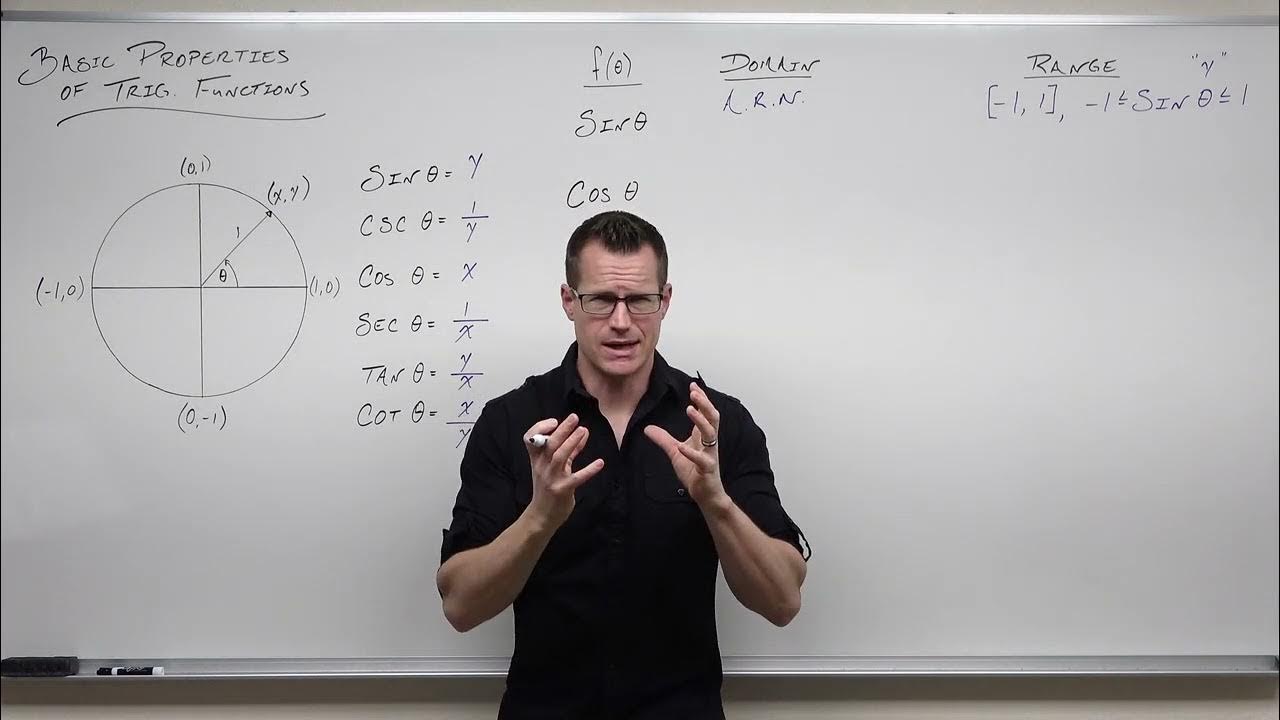The Ranges of Trigonometric Functions
TLDRThis video delves into the ranges of trigonometric functions, emphasizing their importance in calculus and other math courses. It highlights that sine and cosine are bounded between -1 and 1, while tangent and cotangent can vary across all real numbers. The video also explains the ranges of cosecant and secant based on the reciprocal nature of sine and cosine. Through examples, it demonstrates the possibility or impossibility of certain trig function values, reinforcing the key concept that tangent and cotangent have an unrestricted range, which is particularly crucial for understanding calculus.
Takeaways
- 📌 The range of the sine function (sin(θ)) is between -1 and 1, which is a crucial identity to remember.
- 📌 Similarly, the range of the cosine function (cos(θ)) is also between -1 and 1.
- 📌 The tangent (tan(θ)) and cotangent (cot(θ)) functions can take any real number as their value.
- 📌 Given that sine's range is between -1 and 1, the cosecant (csc(θ)) function, being the reciprocal of sine, can have values greater than or equal to 1 and less than or equal to -1.
- 📌 The secant (sec(θ)) function, which is the reciprocal of cosine, follows the same range logic as cosecant, being either greater than or equal to 1 or less than or equal to -1.
- 📌 The script emphasizes the importance of understanding the ranges of these trigonometric functions, especially for calculus and other math-related studies.
- 📌 A quick example provided in the script demonstrates that it is impossible for cos(θ) to equal the square root of 3, as this value exceeds the range of cosine.
- 📌 The script also addresses the possibility of tan(θ) being equal to π/75, confirming that it is possible since tangent's range is all real numbers.
- 📌 Another example shows that sin(θ) can indeed be equal to 0.02, as it falls within the established range of -1 to 1.
- 📌 The key takeaway from the video is the versatility of tangent and cotangent functions, whose range encompasses all real numbers, making them particularly useful in calculus.
Q & A
What is the range of the sine function?
-The range of the sine function is between -1 and 1, inclusive.
Is it possible for the cosine function to have a value outside the interval [-1, 1]?
-No, the cosine function also has a range between -1 and 1, inclusive.
What is unique about the range of the tangent function compared to sine and cosine?
-The tangent function can take any real number as its value, unlike sine and cosine which are bounded between -1 and 1.
How does the range of the cotangent function differ from that of the tangent?
-The cotangent function, being the reciprocal of the tangent, can also take any real number as its value.
What is the range of the cosecant function considering the range of the sine function?
-Since cosecant is the reciprocal of sine, its range is all real numbers except for 0, as dividing by zero is undefined.
Similarly, what can we infer about the range of the secant function?
-The secant function, being the reciprocal of the cosine function, will also have a range excluding 0, as the cosine function cannot be zero.
Why is the range of the tangent function particularly useful in calculus?
-The unbounded range of the tangent function makes it especially useful in calculus for analyzing functions that can approach or diverge to infinity.
If the cosine of theta is equal to the square root of 3, is this statement possible?
-No, since the cosine function cannot exceed 1 in absolute value, and the square root of 3 is greater than 1, this statement is impossible.
Is it possible for the tangent of theta to equal PI/75?
-Yes, since the tangent function can take any real number as its value, it is possible for the tangent of theta to equal PI/75.
Can the sine of theta be equal to 0.02?
-Yes, as 0.02 is a number between -1 and 1, it is within the range of possible values for the sine function.
What should one remember as a key takeaway from this discussion on trigonometric function ranges?
-The key takeaway is that the tangent and cotangent functions can take any real number as their values, which is particularly important for understanding their behavior in calculus and other mathematical contexts.
Outlines
📚 Introduction to Trigonometric Functions' Ranges
This paragraph introduces the concept of ranges for trigonometric functions, emphasizing the importance of understanding these ranges for calculus and other math courses. It highlights the key identity that the sine of theta (sin(θ)) and cosine of theta (cos(θ)) both range between -1 and 1. The tangent (tan(θ)) and cotangent (cot(θ)) functions are noted to have a range of all real numbers. The video then sets up a framework for determining the possible values of related trigonometric functions like cosecant (csc(θ)) and secant (sec(θ)), which are reciprocals of sine and cosine, respectively, and thus have ranges that exclude -1 and 1.
Mindmap
Keywords
💡Trigonometric Functions
💡Ranges
💡Sine (sin)
💡Cosine (cos)
💡Tangent (tan)
💡Cotangent (cot)
💡Cosecant (csc)
💡Secant (sec)
💡Reciprocal
💡Key Identities
💡Calculus
💡Math Classes
Highlights
The video discusses the ranges of trigonometric functions, which is crucial for calculus and other math classes.
A key identity to remember is that the sine of theta (sin(θ)) lies between -1 and 1.
Similarly, the cosine of theta (cos(θ)) also ranges between -1 and 1.
Tangent (tan(θ)) and cotangent (cot(θ)) can take any real number as their value.
The range of tangent and cotangent is all real numbers.
The reciprocal of sine, cosecant (csc(θ)), will be less than or equal to -1 or greater than 1.
Secant (sec(θ)), like cosecant, is either less than or equal to -1 or greater than 1.
The video presents a method to determine whether a trigonometric equation is possible or impossible based on the ranges of the functions.
For example, cosine of theta cannot equal the square root of 3 since it is impossible for cos(θ) to be greater than 1.
Tangent of theta can equal π/75 because tan(θ) can be any real number, making this equation possible.
It is possible for sine of theta to equal 0.02, as it lies within the range of -1 to 1.
The most important takeaway is that tangent and cotangent can vary across the entire spectrum of real numbers.
The video emphasizes the practical applications of these ranges, particularly in calculus.
Understanding the ranges of trig functions is essential for solving mathematical problems and equations.
The video provides a clear and concise explanation of the ranges of sine, cosine, tangent, cotangent, cosecant, and secant.
The reciprocal nature of cosecant and secant in relation to sine and cosine is highlighted.
The video uses the concept of ranges to solve simple questions about trigonometric functions.
The video's content is designed to help viewers understand and apply the ranges of trig functions in various mathematical contexts.
Transcripts
Browse More Related Video

Trig - 0.3 Domains of Trigonometric Functions

Basic Properties of Trigonometric Functions (Precalculus - Trigonometry 8)

Lesson 4 - Inverse Hyperbolic Functions (Calculus 2 Tutor)

Cofunction Identities Examples & Practice Problems Trigonometry

Trig - 0.6 Trig Functions of Acute Angles

Derivatives of Trigonometric Functions
5.0 / 5 (0 votes)
Thanks for rating: